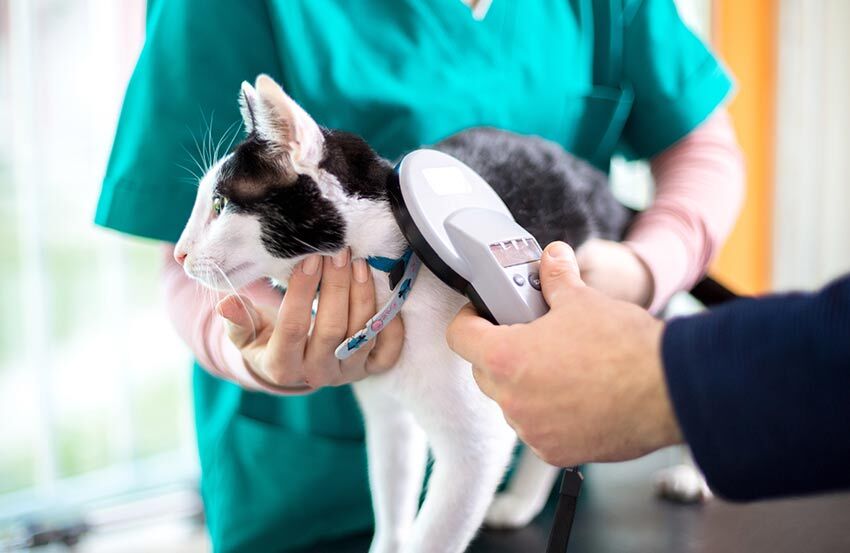Losing a pet is every owner's nightmare. Whether your dog's slipped the lead or your cat's got a taste for adventure, pets can go missing in an instant. That's where microchipping makes all the difference.
Think of it as an invisible form of ID that can't fall off, get lost, or be chewed up. These tiny chips are about the size of a grain of rice, but they make a big impact.
So let's take a look at how these tiny wonders work - and how they can give you peace of mind if you get separated from your four-legged companion.

Why microchipping matters for cats and dogs
Microchipping increases the likelihood of your pet's safe return if they get lost or even stolen.
A microchip is a tiny electronic chip, about the size of a grain of rice. It's implanted under the animal's skin, usually between the shoulder blades. The chip contains a unique identification number that can be read by a scanner, linking to the owner's contact details.
Unlike collars or tags, a microchip is a permanent form of ID that can't be lost or removed.
Is microchipping your cat or dog a legal requirement?
Yes, it is a legal requirement for your dog or cat to be microchipped in England. This law has been in place for dogs since 2016 and was recently stretched to include cats in 2024.
Dogs must be microchipped by 8 weeks old, and cats must be microchipped by 20 weeks old. This also includes indoor cats. So, make sure getting them microchipped is on your checklist as a new pet owner.
You must make sure that your dog or cat is registered at a database that meets government standards. Below are the accepted databases outlined at GOV.UK:
-
AnimalData
-
Animal Microchips
-
Animal Tracker
-
ChipHERO
-
Chipworks
-
DKC
-
HomeAgain
-
Identibase
-
Lost Paws
-
MicroChip Central
-
MicroDogID (racing greyhounds only)
-
My Animal Trace
-
MyPet
-
National Veterinary Data Service
-
Pet Database
-
Pet Identity UK
-
Petlog
-
PetScanner
-
ProtectedPet
-
SmartTrace
-
Track Your Paws
-
UK PETtrac MicroChip Database
-
We Trace Pets
There are some exemptions, such as for dogs or cats that are certified as medically unfit to be microchipped by a veterinarian, according to BSAVA.
Owners found to have not microchipped their pet (or not kept their contact details up to date) can be fined up to £500.
It's also worth noting that as well as receiving a fine, you could invalidate your pet insurance if you don't get your cat or dog microchipped.
You'll also need to ensure they're microchipped if you plan on travelling with your pet.
How much does it cost to microchip a cat or dog?
Typically, the cost to microchip a cat or dog ranges from around £10 to £30. But this price can vary depending on your location and chosen provider. Some vets might offer microchipping as part of a package, especially for puppies and kittens.
Some animal charities or shelters might even offer the service for free or at a reduced cost.
You might find that there are additional fees for updating your contact details, but these are usually small.
Where can you get your pet microchipped?
There are many places you can get your pet microchipped. Let's take a look at your options:
-
The vets: Your local vets are probably your first port of call when it comes to microchipping. A vet or veterinary nurse will be able to microchip your furry friend.
-
Animal charities: Organisations like the RSPCA, Dog's Trust, and The Blue Cross offer microchipping services. Usually these will be at a reduced cost too.
-
Local authorities: Some local councils offer microchipping, sometimes free of charge. Check with your local council's animal services or environmental health department, as they may offer these services or have information on local providers.
What to expect during the microchipping procedure
Taking your pet to get any veterinary procedure can be daunting. Especially if your puppy or kitten isn't used to new environments yet. Luckily, the microchipping process is relatively quick and painless. The discomfort felt will be very brief and similar to that of a vaccination your pet gets.
A vet or trained professional will inject a small chip, about the size of a grain of rice, under the loose skin between your pet's shoulder blades. The procedure is a speedy one - and it'll be over in just a few seconds. Your pet usually won't need any anaesthesia or recovery time.
Some pets experience mild, temporary discomfort or swelling at the injection site immediately after the procedure. But serious complications are rare. Potential complications include microchip migration (the chip moving from its original location) and infection at the implantation site.
Other than plenty of cuddles, there's no specific aftercare needed. Infection is rare, but you can keep an eye on the injection site for any signs of swelling. If you have any concerns, it's always worth contacting your vet.
Keeping your pet's microchip details up to date
Unlike a collar or tag, we can't see a microchip once it's been implanted, so it can be easy to forget about them. But it's important to remember to update your contact information if it changes. Having the wrong details could spell disaster if your pet goes missing.
Your contact details might change for a number of reasons. You might have moved house, or your pet might have changed owners. If this is the case, you'll need to update the registration to reflect the new owner's details. The previous owner may need to initiate the transfer through their account, and you'll receive a notification to accept the change.
But how do you update your information? Let's go through the steps:
-
Identify the database: If you don't know which database your pet is registered with, you can take your pet to a vet or animal shelter to have the microchip scanned. They can identify the database. Or you can use a microchip lookup tool like Check-a-Chip.
-
Contact the specific microchip database your pet is registered with: You'll need the microchip number and your updated information, such as your address or phone number. Some databases offer online portals for updates, while others may require phone calls or even postal mail.
-
Confirm the update: Ensure you receive confirmation that the changes have been successfully made.
-
Double-check: It's a good idea to double-check the updated information after a few days to ensure it's correct.
Be aware that some databases may charge a fee for updates, especially if you choose to update by phone or mail.
Does pet insurance cover microchipping?
Microchipping isn't usually covered under standard pet insurance policies. This is because many insurers treat microchipping as a 'routine' procedure that's part of your legal responsibility as an owner.
But lots of pet insurance policies offer lost and found cover. This could help fund adverts to help find your missing pet.

